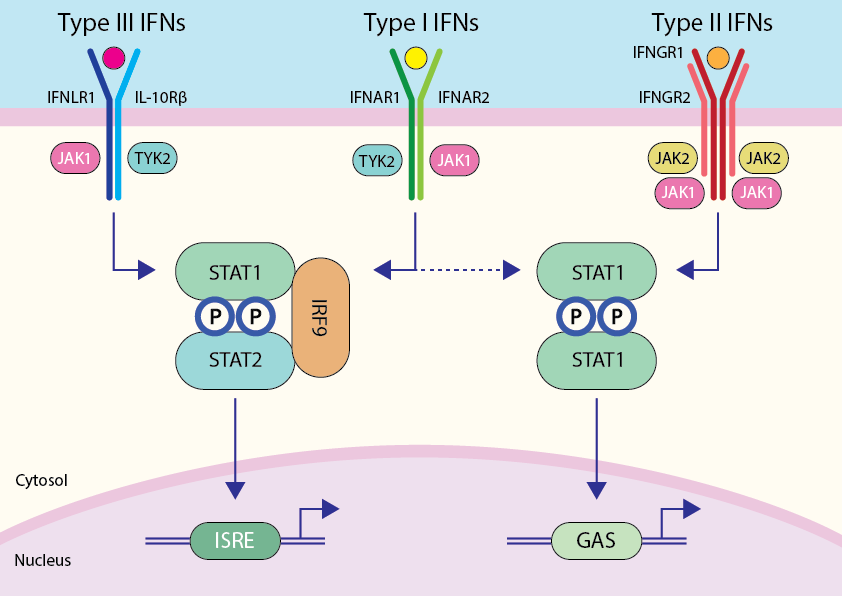You have no items in your shopping cart.
Interferons
Interferons are a group of signaling proteins produced by cells in response to viral infections, certain bacteria, parasites, cancer, and other immune triggers. They play a critical role in the immune response against pathogens and tumors. Interferons are part of the innate immune system and serve as one of the first lines of defense against infections.
There are three main types of interferons: Type I, Type II, and Type III
- Type I Interferons: This group includes interferon-alpha (IFN-α) and interferon-beta (IFN-β), alongside IFN-ε, IFN-κ, and IFN-ω. Type I interferons are primarily produced by virus-infected cells and some immune cells, such as dendritic cells. They induce antiviral responses in neighboring cells, inhibit viral replication, and enhance the activity of natural killer cells and macrophages.
- Type II Interferon: This type consists mainly of interferon-gamma (IFN-γ). Unlike Type I interferons, IFN-γ is primarily produced by activated T cells and natural killer cells in response to specific stimuli, such as antigens or cytokines. IFN-γ plays a critical role in activating macrophages and promoting immune responses against intracellular pathogens, including viruses and certain bacteria.
- Type III Interferons: This group includes interferon-lambda (IFN-λ). Type III interferons have antiviral activity similar to Type I interferons but act through a different receptor complex. They are produced by various cell types, including epithelial cells, and play a role in defending against viral infections, particularly at mucosal surfaces.
Interferons and their Receptors

Type I Interferons (IFN-α and IFN-β)
Type I interferons bind to a heterodimeric receptor complex known as the interferon-alpha receptor (IFNAR). IFNAR consists of two subunits: IFNAR1 and IFNAR2. Both subunits are necessary for functional receptor signaling.
The binding of type I interferons to IFNAR activates Janus kinases (JAKs), specifically JAK1 and Tyk2, leading to phosphorylation and activation of signal transducer and activator of transcription (STAT) proteins, primarily STAT1 and STAT2. The activated STAT proteins form complexes with interferon regulatory factor 9 (IRF9), resulting in the formation of the interferon-stimulated gene factor 3 (ISGF3) complex.
ISGF3 translocates to the nucleus, where it binds to interferon-stimulated response elements (ISREs) in the promoter regions of interferon-stimulated genes (ISGs), leading to the transcriptional activation of a wide range of antiviral and immunomodulatory genes.
Type II Interferons (IFN-γ)
IFN-γ binds to a homodimeric receptor complex known as the interferon-gamma receptor (IFNGR). IFNGR consists of two subunits: IFNGR1 and IFNGR2. Both subunits are required for functional receptor signaling.
The binding of IFN-γ to IFNGR activates JAK1 and JAK2 kinases, which in turn phosphorylate STAT1. Phosphorylated STAT1 forms homodimers and translocates to the nucleus, where it binds to gamma interferon-activated sequence (GAS) elements in the promoter regions of target genes, leading to the transcriptional activation of various immune-related genes, including those involved in antigen presentation, immune cell activation, and antimicrobial responses.
Type III Interferons (IFN-λ)
Type III interferons bind to a receptor complex composed of IFNLR1 (also known as IL-28Rα) and IL-10Rβ (also known as IL-10R2).
The binding of type III interferons to IFNLR1/IL-10Rβ activates JAK1 and Tyk2 kinases, leading to phosphorylation and activation of STAT1 and STAT2.
Similar to type I interferons, the activated STAT proteins form complexes with IRF9, resulting in the activation of ISGs and induction of antiviral responses.
Discover our range of interferons, along with their receptors:

.png)